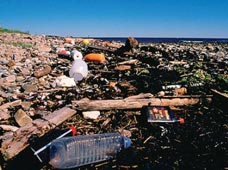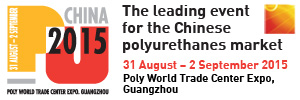Also, download this story from the electronic issue here
Confronted by a gargantuan waste mishap like marine litter, one may think the situation irreversible. Nevertheless, the plastics industry is confident that practical solutions, such as plastics waste management, may be able to offer help, says Angelica Buan in this article.
Studies have found marine litter to have alarmingly extended from the deepest ocean depths to the surface and afflicting at varying concentration levels five major gyres (major spirals of ocean-circling currents that occur north and south of the equator). Waste plastics, which are found to represent a large bulk of the marine debris by material type, can enter the environment a number of ways, including improper waste management, and dumping or littering shorelines or at sea. These waste plastics will eventually degrade into fragments.

Marine litter is a global affair that has provoked the issue of plastics endangering the environment. In the Asia Pacific region, the European Commission (EC) estimates that marine litter could cost over US$1.26 billion/year damage to marine industries (shipping, tourism and fishing) or 3% of the GDP for the 21 economies in the region. At the other end, the average cost of clearing up plastic waste in the region could cost US$1,500/tonne of waste.
Hot on plastics: plastics associations work together
A global-wide assembly of 60 plastics associations from 34 countries has fostered a manifesto to address the issue of marine litter. The Declaration of the Global Plastics Associations for Solutions on Marine Litter, which started in 2011, represents the industry’s commitment and focuses on education, research, public policy, sharing best practices, plastics recycling/recovery, and plastic pellet containment.

According to the group’s 2014 progress report, poor waste management and sewage overflows mostly account for landbased sources that make up 80% of marine litter. Meanwhile, oceanbased sources include “trash from boats, abandoned fishing gear, and natural disasters”. About 70% of marine litter, such as glass, metal, and all sorts of marine equipment, sink to the ocean floor and the rest floats or remains suspended in water.
According to Jürgen Brüder Managing Director of Germany-headquartered IK Industrievereinigung Kunststoffverpackungen eV, in Germany, land-sourced litter from dumps, ports, coastal regions and river navigations ultimately goes into main waterways. On a similar note, Doug Woodring, co-founder of US/ Hong Kong-based NGO Ocean Recovery Alliance (ORA), emphasised the need to develop technologies that will provide better understanding of how litter infiltrates waterways. Both presenters were speaking during the 25th annual Global Meeting on Plastics and Sustainability, held in December 2014 in the Philippines.
The growing hostility on plastics is due to its floatation nature and resistance to degradation, according to the delegates.
Lim Kok Boon, President of the Malaysian Plastics Manufacturers Association (MPMA), reiterated that plastics per se are not the issue but the way plastics are disposed of. “People talk about plastics being a problem in the environment because of the nondegradation factor. In Malaysia, plastics are commonly regarded as a local waste problem, rather than a marine litter problem,” he said at the meeting.
Woodring of ORA said that currently Hong Kong generates 1,700 tonnes of plastics/day that accounts for 20% of total municipal solid waste. He added that a municipal solid waste (MSW) plan has been instituted in the country to reduce MSW by 40% by 2022; recycling will also be increased by 55%.
Reinventing strategies to change public mindset
Defending plastics by citing their benefits is no longer an effective game plan to raising awareness on marine littering, observed Asian association heads.
“When we speak about plastics being sustainable, the public does not listen, plus in Malaysia we still have this NIMBY (not in my backyard) syndrome,” shared MPMA’s Lim. “Being on the defensive also does not work. Hence, we clarify that littering is what creates the problem in the environment.”

Meanwhile, Crispian Lao, spokesperson for the Manilabased Philippine Plastics Industry Association (PPIA), says that the public has become immune to the usual plastics versus paper debate.
“To discontinue the disagreements, we have shifted to talking about recycling plastics and paper in general,” he said.
How are the associations tackling the waste problem? MPMA has employed a strategy of “engage, displace, educate and promote” through a series of interactive campaigns and programmes. “We engage with the public, break through barriers, create mutual trust, and only then will we be able to dispel the negative perception about plastics,” explains Lim.
He goes on to say, “By tackling the issue of waste, we will also indirectly tackle the marine litter problem, because 80% of marine litter is from landbased activities.”
Meanwhile, PPIA is investing more on tangible projects than on public relations (PR) campaigns. “We are focusing on actual programmes that really mean something to the public. Because all talk with no action makes no sense,” Lao said. “Campaigns must be supported with complete sustainable programmes,” says Lao, who is also a commissioner of the National Solid Waste Management Commission (NSWMC).
Reaching out through popular means
Lao said that programmes with added value encourage cooperation. “Unless we put a value on waste there will be no participation. It is a question of what’s in it for me?” he said.
An example is PPIA’s project known as Bigas Ko, Plastic Mo (My rice grains, your waste plastics), through which people can trade 1 kg of waste plastics for 1 kg of rice. “This is a very successful programme. People even pick up candy wrappers in exchange for rice,” he said.
Recyclable materials like plastic bags, laminates, and composites are exchanged in kind for promotional items (including condiments like soy sauce and cooking vinegar) from participating companies. Laminates are converted to school chairs.
A partnership with a social enterprise founded by American artist and designer Ann Wizer, the Invisible Sisters, has enabled wastes plastics to be repurposed into crocheted bags and clothing materials while at the same time providing livelihood to community women.
Recycling kicks off
Steve Russell, Vice President of the American Chemistry Council (ACC), told delegates at the Manila-held meeting that new innovations in recycling and energy recovery can aid in efficient management of used plastics. “We look forward to closer cooperation with our colleagues in Asia and throughout the world to develop locally relevant and sustainable approaches to recycle and recover the energy from used plastics,” he said.

Malaysia is also actively improving the public’s response to recycling. Lim said that MPMA has implemented sustainable programmes that have been on-going since 2002, including the 3Rs (reduce, reuse, and recycle). “In 2012, we launched a very simple programme known as the HI5 Me (Me stands for Mother Earth). It makes use of a big hand sign in a high-five hand gesture. We are able to attract the attention of the public to convey the message that the issue is about littering,” he said.
The Malaysian association is also carrying out the “Don’t be a Litterbug” campaign, which is espoused by the Malaysian Plastics Forum (MPF), a group established in 2005 that comprises the Malaysian Petrochemicals Association-Plastics Resins Producers Group (MPA-PRPG) and MPMA.
“This campaign is aimed at preventing plastics from entering the environment and fighting the littering habit among Malaysians,” stressed Lim.
Harnessing waste for energy
Plastics have a higher captured energy than wood, paper or even coal, according to ACC. There are a few technologies available to recover energy, or convert solid waste into feedstock materials or renewable energy.
In the Plastics to Oil presentation at the plastics meeting last December, ACC lists these as: mass burn waste-to-energy, which produces electricity and steam; engineered solid fuels that produce alternative solid fuel and coal/coke replacements; gasification, which produces electricity and/or fuels (ethanol) and chemicals; and plastics-to-oil, which produces synthetic crude oil and drop-in fuels.
While the waste-to-energy (WTE) method is a welcome option to recover plastics, there is opposition to its potential risks to health and safety.
In the Philippines, PPIA said that it is currently in the midst of developing guidelines for WTE together with environmental agencies and NGOs.
PPIA’s Lao said, “The solid waste commission wants to ensure environmental protection. With the guidelines coming from the national government, incineration will be allowed.”
Meanwhile, Lao also said that NGOs were pushing PPIA to exclude PVC from the list because of potential risks like dioxin emissions. But he opined that science-backed evidences are likely to assure NGOs that materials like PVCs can be safely recycled.
Fixing the glitch
In the light of the marine litter woes, agencies and industry players are setting targets to decelerate, if not to curb completely, the growing rate of ocean pollution.
For example, the EU Commission has set a marine litter reduction target of 30% by 2020. Likewise, the ACC will be proposing collaborative approaches to sustainable waste management at the Asia Pacific Economic Cooperation (APEC) forum to be held later this year in the Philippines. APEC promotes ocean cooperation amongst its members.
On the other hand, MPMA is implementing efforts at the grassroots level with its anti-litter campaign in Malaysia. It hopes the campaign will change the mindset of proponents of anti-plastics and instead make them look at it as an anti-litter issue.
“Let us give life to our valuable resources,” Lim of MPMA says.
PPIA’s Lao opines that the plastics industry must take a more active role in raising awareness about plastic waste management as well as the technologies that enable efficient waste management.
“We cannot continue with the same level of thinking. We have to re-invent ourselves to address the problems that we have generated for ourselves. Let’s face it: we need to address the plastic waste problem, because we are the ones who produce plastics,” says Lao in conclusion.
(PRA)































